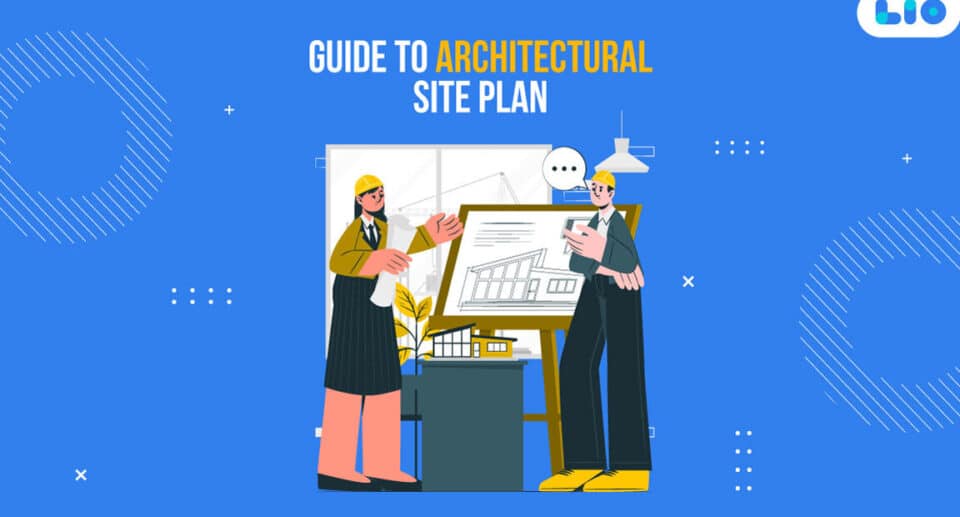The Ultimate Guide to Architectural Site Plan 2024
Gourav Jain
- August 31, 2023
- 10 Min Read

In the realm of architecture, site planning holds massive importance. Architectural site plan is one of the essential components of the design process, which serves as the blueprint for creating spaces and buildings that seamlessly blend with the surroundings.
The site plan must hold the comprehensive details of the site, leaving no room for interpretation. Architectural site plans are crucial as they guide the entire design process, help in decision-making, and ensure that the project aligns with zoning regulations, environmental considerations, and the overall vision of the development.
This article discusses the site plans in architecture, their purpose, key elements and components, and the benefits they offer in creating extraordinary architectural designs.
What is an Architectural Site Plan?
A site plan is a clear and detailed visual representation of a property’s layout and design that depicts the location in context with the surroundings. It is a comprehensive guide architect use that showcases the site’s unique features. A well-crafted site plan includes site boundaries, building placement, access points, landscaping, and infrastructure.

Master Architectural Project Execution
Master the art of architectural project execution with our tailored project management solutions. Streamline tasks, enhance communication, and drive success in every phase of your projects.
Key Elements of Architectural Site Plan
During the site planning, architects strike a perfect balance between functionality, aesthetics, and practicality. They carefully analyze and integrate these key elements into the site plan and create a cohesive design that optimizes the site’s potential.
Site Boundaries and Property Lines
This is one of the fundamental aspects of site planning. Architects need to accurately depict the site’s boundaries and property lines, including edges of the property, to define the extent of the area that will be considered in the design. Site boundaries help architects work within the designated space and ensure compliance with legal requirements.
Building Footprint and Placement
The building footprint defines the outline or shape of the projected structure on the site plan. It indicates the location and size of the building, including any additional structures such as garages or outbuildings. Defining the footprint and placement of the structure is crucial for factors like natural lighting, views, and functionality with other site elements.
Access Points and Circulation
Architects determine the locations of entrances, driveways, parking areas, and pedestrian pathways. Architects ensure convenient and safe movement throughout the site by strategically placing the access points. Other factors like traffic flow, pedestrian safety, and compliance with accessibility guidelines are also considered by the architects.
Landscaping and Open Spaces
Everyone wants an open space of green space in their structures. Architects integrate the site’s green spaces, gardens, parks, and recreational areas. These areas enhance the site’s aesthetic appeal and provide room for relaxation, socialization, and interaction with nature.
Utilities and Infrastructure
Architects identify the locations of crucial infrastructure elements, including water supply lines, sewer connections, electrical systems, and telecommunication networks. The efficient placement of utilities ensures that the site is adequately equipped to support the projected design of the building or development. The architects also consider stormwater management, wastewater treatment, and other environmental factors.
Purpose and Benefits of Site Plan in Architecture
Architectural site plan plays a crucial role in the building design process and also offers numerous benefits, some of which include:
Informing Design and Layout Decisions
Architectural site plan provides some essential information about the site to the architects that helps them make informed design decisions. Architects analyze the factors such as topography, existing vegetation, and surroundings and maximize the potential by determining the optimal placement and orientation of buildings.
Visualizing Spatial Relationships
Site plans offer a bird’s-eye view of the site, allowing architects and stakeholders to visualize the spatial relationships between different elements. This visualization aids in understanding how buildings, pathways, and open spaces interact, contributing to the overall functionality and aesthetics of the site.
Ensuring Regulatory Compliance
Architects adhere to zoning regulations and building codes with the help of architectural site plans. Architects can ensure compliance with local regulations and avoid potential legal and construction complications by accurately showcasing the setbacks, property lines, and other required elements.
Enhancing Site Functionality and Efficiency
By considering access points, circulation routes, and utility placements, architects can create a building/structure layout that facilitates smooth movement, efficient infrastructure integration, and enhanced user experience.

Embrace Precision in Architectural Project Management
Precision matters in architecture. Discover how our project management tools empower architects to plan meticulously, manage resources efficiently, and ensure every detail aligns flawlessly.
Process of Creating an Architectural Site Plan
An architect needs to follow a systematic process and approach to create an effective architectural site plan; the steps include:
Gathering Site Information and Data
The first step of the architectural site plan is collecting essential information about the site. This data includes property boundaries, topographic surveys, and utility locations and is the foundation for accurate site planning.
Conducting Site Analysis and Assessment
Architects conduct a thorough site analysis and analyze the aspects such as climate, vegetation, neighboring structures, and site constraints. This analysis helps architects identify opportunities and challenges that influence the design process.
Determining Design Objectives and Constraints
Architects define the design goals and limitations based on client requirements, site analysis findings, and project objectives. These objectives are the ultimate guide for creating the architecture site plan and ensuring it aligns with the desired outcomes.
Generating the Site Plan
The site plan is developed by translating the gathered data, information, and design objectives into a visual representation. This visual representation includes scale, dimensions, and orientation of the plan, as well as incorporating symbols and notations to represent various site elements accurately.
Key Considerations for Architectural Site Plans
Certainly, there are multiple factors that architects take into consideration while developing site plans. These factors include:
Zoning and Building Codes
Architects must build site plans that adhere to the local zoning regulations and building codes. Compliance with setback requirements, building height restrictions, and parking standards is essential to ensure project feasibility and legal compliance.
Site Accessibility and Circulation
Creating accessible pathways, parking areas, and entrances is crucial for convenience and compliance with the accessibility guidelines. Architects carefully design circulation routes to optimize movement and promote safety within the site.
Sustainability and Environmental Factors
Architects should integrate sustainable design principles, such as incorporating green spaces, natural lighting, and energy-efficient strategies in the architecture site plan. Architects can create environmentally responsible designs by harmonizing the built environment with the natural surroundings.
An architect should consider other factors before site planning: natural factors, topography, soil, vegetation, hydrography, geology, cultural and climatic factors, and wildlife.
Integration of Landscaping and Open Spaces
Integration of landscaping and open spaces within the site plan enhances the overall aesthetics of the space and makes it more functional. Components, including gardens, recreational areas, and green spaces, can contribute to a visually pleasing and sustainable site design.
Tools and Techniques for Designing Site Plans
Architects use multiple tools and technologies to create effective site plans. Below are some of the software used by the architects and designers:
Computer-Aided Design (CAD) Software
CAD software helps architects in creating accurate and detailed architectural site plans. CAD has some amazing features, like precise measurement tools, easy editing capabilities, and the ability to create 3D visualizations.
Geographic Information Systems (GIS)
GIS technology provides valuable data insights and amazing mapping capabilities supporting site analysis and visualization. GIS allows architects to overlay various data layers, such as topography, land use, and utilities, for a complete understanding of the site.
Visualization and Rendering Tools
Visualization and rendering tools help architects present site plans in a visually appealing and realistic manner. These tools enable the creation of 3D models, virtual walkthroughs, and renderings that bring the site plan to life for clients and stakeholders.

Redefine Architectural Possibilities
Our platform equips you with the tools to streamline your project lead management, collaborate seamlessly, and push the boundaries of design. Embrace innovation with Lio today.
How Lio can help you?
Managing a site is a headache; to eliminate this struggle, Lio is here to help you. This all-in-one project and workflow management tool has in-built customizable project management, data management, and resources management apps that let you manage all sorts of workflow together in a more organized way than ever.
This cloud-based project management tool helps you visualize your data through real-time business dashboards, generate reports instantly, collaborate, and share significant data while working on your site.
Lio offers premium automation and workflow management features that let you manage and automate your project workflows, resources, tasks, and data in a single space. Besides all these, you can also track your site estimates, make budgets, keep an eye on your project finances, create dashboards, collaborate with your team in real time, and automate your project or site management workflow all in one go.
You will certainly manage your site more efficiently if you go on this journey of managing it with Lio.
Conclusion
Architectural site plans are an essential component of design that serves as a roadmap for creating more balanced and functional structures. Architects can easily optimize the site’s potential and develop extraordinary architectural designs by carefully considering site components, complying with regulations, and incorporating sustainable design principles.
Effective tools, site analysis, and informed decision-making are key to creating a visually appealing and harmonious architectural site plan.
Frequently Asked Questions (FAQs)
What is a site plan vs a floor plan?
A site plan is an overview of the entire property, highlighting its exteriors, external elements, and surroundings; conversely, a floor plan focuses on the interior layout and features of a single floor within a building.
What are the 5 things on a site plan?
A site plan includes detailed information about the site that includes,
- Site boundary
- Property lines
- Location of sidewalks, streets, and other features
- Outdoor spaces like parking, driveways, etc
- Topographic features
Moreover, the architecture site plan also includes the following:
- Construction limits and laydown areas.
- Landscape areas.
- Fire hydrants.
- Existing and projected conditions.
- Other site details.
What is the first step in site planning?
Kevin Andrew Lynch has defined 8 stages in site planning, and the first step is defining the problem. An architect must define the problem during the site planning, per the brief and requirements.
What is elevation in architecture?
An image that showcases the shape and size of the structure. The shape and size include the structure’s height, length, breadth, and appearance.
What is the size of a site plan?
The size of site plans depends on the complexity of the architecture project; in all probabilities, the site plans are scaled at 1:500 or 1:200. Although the architects or professionals may use larger scales for smaller projects and small scales for larger projects.
Can Lio help you in architectural site management?
Lio is a one-stop solution for data and workflow management. Architects can easily manage their projects, site data, resources, workflows and collaborate with their teams in real-time. You will find managing your site and projects much easier on this all-data and workflow management tool. You can call our sales and support team for more information.







